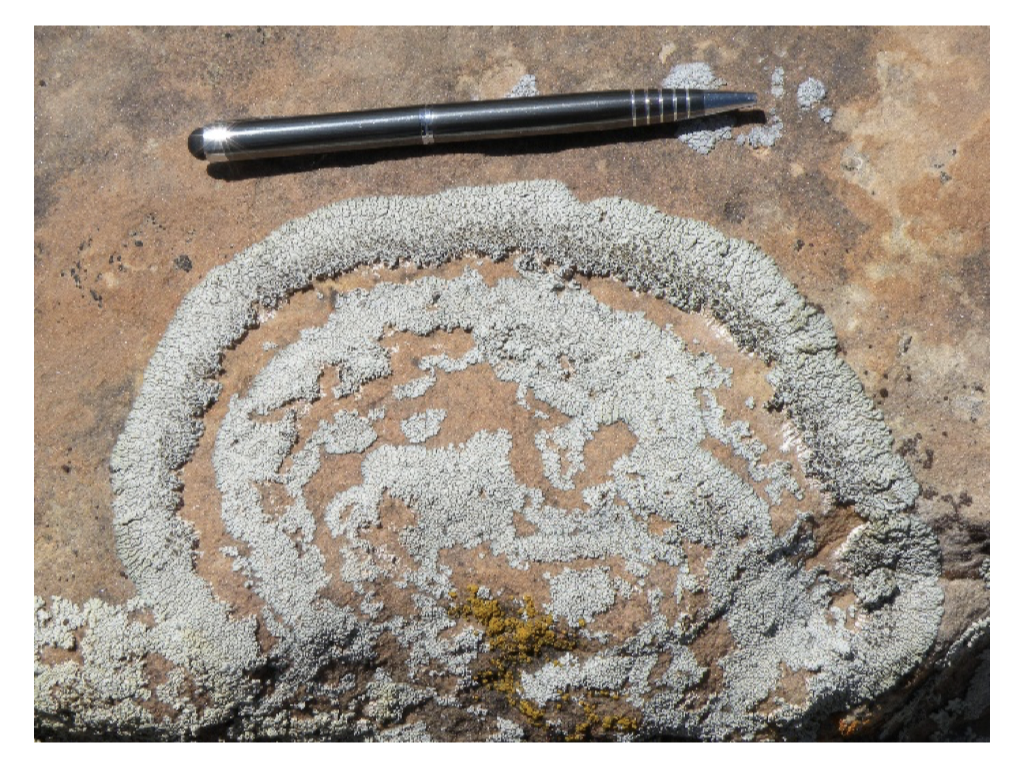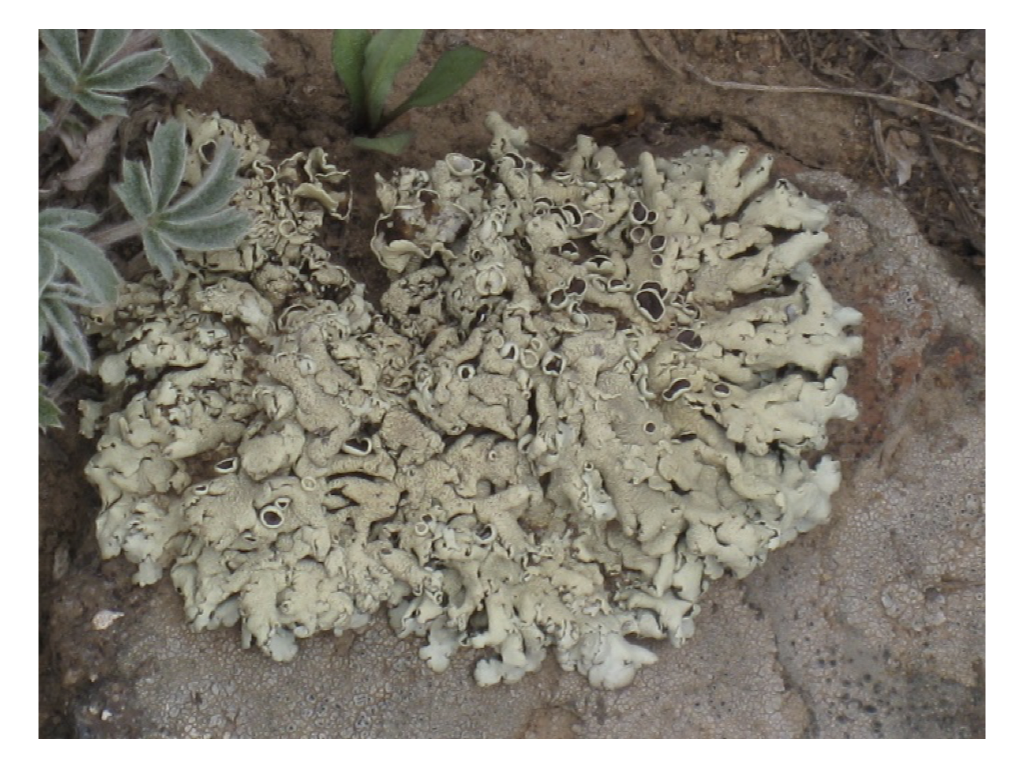Fungi are a diverse group of eukaryotes. About 150,000 species have been described. However, this is almost certainly a gross underestimate of fungal species, which are estimated to number 1-5 million. Fungi were historically classified with the plants due to superficial similarity in growth forms. However, they are much more closely related to animals. Today we classify them with animals in Supergroup Opisthokonta.
Like all opisthokonts, fungi lack plastids and are heterotrophs. Unlike the other major group of opisthokonts (animals) they obtain their nutrition by extraorganismal digestion. Fungal cells secrete hydrolytic enzymes, called exoenzymes, which digest food items in the environment. The smaller molecules that result from digestion are then absorbed by the fungus. Many fungal species are saprobes, organisms that feed on decaying organic matter. Others exist in symbioses with other organisms.
Fungi are characterized by a cell wall that contains complex polysaccharides, including chitin and glucans. Their plasma membranes contain ergosterol, which functions to stabilize the membrane, much like cholesterol in animal cell membranes. They use glycogen as an energy storage molecule.
Fungi can be either unicellular or multicellular, or they may switch between these two states. They exist in a variety of growth forms. Unicellular fungi are called yeasts. Multicellular fungi are filamentous. The filaments are called hyphae (sing. hypha), and a mass of filaments is called a mycelium. Hyphae are most commonly septate, meaning that internal cell walls (septa) divide the filament into compartments. These cell walls are perforated with pores, allowing materials to pass between compartments. Less common are coenocytic fungi, which lack septa.

Fungi reproduce asexually and sexually. For many species, no sexual form is known. Others switch between sexual and asexual reproduction. Both sexual and asexual reproduction rely on spores that disperse from the parent organism. Sexual reproduction is variable; a generalized fungal life cycle is shown. Fungi fuse the cytoplasm and nuclei in separate steps. Plasmogamy is the fusion of cells. We refer to the product of plasmogamy as a heterokaryon because it contains genetically distinct nuclei. The nuclei may not fuse for days, months, or years. Fusion of nuclei is called karyogamy, and results in a diploid zygote. The zygote undergoes meiosis to form spores, which give rise to a new haploid individual.
Major Groups of Fungi
The five major groups of fungi are the chytrids, the zygomycetes, the glomeromycetes, the ascomycetes, and the basidiomycetes. We will examine four of these groups in the lab.
Chytrids
Chytrids are traditionally classified into Phylum Chytridiomycota; however, this group is most likely paraphyletic and reclassification is currently in progress. Chytrids are fungi with motile, flagellated spores. This is an ancestral character that other fungal groups have lost. Most chytrids are unicellular, but some species are multicellular with coenocytic hyphae. There are about 1,000 described species of chytrids. Many are saprobes, while others are parasites.
Zygomycetes
Zygomycetes are fungi that use zygospores to reproduce sexually. There are over a thousand species, and are classified in Phylum Zygomycota. However, this is a paraphyletic group that is currently being revised. Zygomycetes generally have coenocytic hyphae. They reproduce asexually by means of spores produced by mitosis. Different mating types can also reproduce sexually. During sexual reproduction, a hypha from each mating type forms a gametangium, which is separated from the rest of the hypha by a cell wall. The two gametangia fuse into a single structure, the zygospore. The zygospore is dikaryotic, containing haploid nuclei from each mating strain until karyogamy, when the nuclei fuse and then undergo meiosis to produce spores.
Glomeromycetes
There are about 230 species of glomeromycetes. They form arbuscular mycorrhizae with up to 90% of land plants. Glomeromycetes usually have coenocytic hyphae and reproduce asexually. We will not examine them in lab, but you should be aware of their critical importance in terrestrial ecosystems.
Ascomycetes
The majority of known fungi belong to the Phylum Ascomycota, which is characterized by the formation of an ascus (plural, asci), a sac-like structure that contains haploid ascospores. Many ascomycetes are of commercial importance. Some play a beneficial role, such as the yeasts used in baking, brewing, and wine fermentation, plus truffles and morels, which are held as gourmet delicacies. Aspergillus oryzae is used in the fermentation of rice to produce sake. Other ascomycetes parasitize plants and animals, including humans.
Asexual reproduction is frequent and involves the production of conidia that release haploid spores. Sexual reproduction takes place in saclike structures called asci. These result from fusion of hyphal structures to produce dikaryotic hyphae, which then produce asci at their tips. Within the asci, karyogamy takes place, resulting in a zygote. The zygote undergoes meiosis. In some species, the haploid cells that result from meiosis divide by mitosis to form eight ascospores.
Basidiomycetes
The fungi in the Phylum Basidiomycota are easily recognizable by their club-shaped fruiting bodies called basidia (singular, basidium), which are the swollen terminal cell of a hypha. The basidia, which are the reproductive organs of these fungi, are often contained within the familiar mushroom. Spores are generally produced through sexual reproduction, rather than asexual reproduction. The club-shaped basidium carries spores called basidiospores. In the basidium, nuclei of two different mating strains fuse (karyogamy), giving rise to a diploid zygote that then undergoes meiosis. The haploid nuclei migrate into basidiospores, which germinate and generate monokaryotic hyphae. The mycelium that results is called a primary mycelium. Mycelia of different mating strains can combine and produce a secondary mycelium that contains haploid nuclei of two different mating strains. This is the dikaryotic stage of the basidiomyces lifecyle and and it is the dominant stage. Eventually, the secondary mycelium generates a basidiocarp, which is a fruiting body that protrudes from the ground—this is what we think of as a mushroom. The basidiocarp bears the developing basidia on the gills under its cap.
Lichens
No discussion of the fungi is complete without (at least) a brief discussion of lichens. Lichens are a common component of terrestrial ecosystems found from the Equator to the Polar Regions. A lichen is a unique type of symbiotic partnership that forms between a multicellular fungus and a unicellular photoautotroph. The fungal partner is referred to as the mycobiont, and the photoautotrophic partner is the photobiont.
The Mycobiont: The fungal partner is almost always an ascomycete fungus (there are about a dozen lichenized basidiomycetes, as well as a few others). Lichenized fungi are found only in lichens (i.e. not as “free-living” individuals), and each type of lichen contains a different species of fungus. For these reasons, the scientific name for the fungus is applied to the lichen. There are between 14,000 and 17,000 named and described types of lichens, which accounts for about 15% of known ascomycete species.
The Photobiont: The photobiont is usually a unicellular green alga (this is the case in more than 90 % of lichens), but in some it is a cyanobacterium (about 8% of lichens). A small number of lichens contain photoautotrophs from other groups (e.g. stramenopiles: yellow-green algae). The unicellular photoautotrophic partner is not limited to the lichen partnership and may be found in a non-lichenized “free-living” state. There are only a small number of photobiont species (about 100) that are found in lichens, so for the photobiont partner this is a non-exclusive relationship. Some lichens contain more than one species of photobiont in different portions of their thallus.
Symbiotic Relationship: The nature of the lichen symbiotic relationship continues to be the subject of research and debate. Although it is typically described as a mutualistic relationship, the fitness of the photobiont may be reduced, leading some lichenologists to describe the relationship as a form of controlled parasitism.
Lichen Ecology: Lichens are often pioneer “species” that are among the first to colonize bare rock or other “available” microhabitats. Many grow on the soil surface (where they are common components of the cryptobiotic soil community), or tree trunks. The cyanolichens (that have cyanobacterium photobionts) are important sources of fixed nitrogen for the nitrogen cycle in ecosystems. Lichens are very sensitive to variation in microclimates. Their extreme sensitivity to certain air pollutants has made them useful as indicators of air quality.
Economic Uses: Economically, lichens are used as food by animals (reindeer graze on lichens in the Arctic Circle) and humans. Some lichens have been used as the source of dyes.
Lichen Organization: Cultured separately, both mycobionts and photobionts are amorphous, but together they form a distinctive and complex body called a thallus. Thallus organization is distinctive, permitting recognition of many different types of lichens on a morphological basis. Lichens also form a number of secondary metabolites that are useful in lichen identification. Secondary metabolites and thallus organization are determined by the mycobiont. Most lichen thalli have an upper cortex formed by tightly interwoven fungal hyphae, and a central medulla formed from loosely woven hyphae. Some lichens also have a lower cortex. The unicellular photobionts are usually found in the upper (and sometimes lower) portions of the medulla. Recently (2016) a third symbiont was identified from a lichen: a unicellular basidiomycete (yeast) located in the upper cortex. Since this initial finding, basidiomycete yeasts have been identified from several additional lichens and may turn out to be widespread. In 2019, a fourth symbiont (a second basidiomycete) was identified in the thallus of the wolf lichen (Letharia). These exciting new findings may be leading to a fundamental re-thinking of the lichen association in the future.
The mycobiont is also responsible for the formation of sexual and asexual reproductive structures. If present, these are useful in lichen identification.
The growth of many lichens is relatively slow, depending on local conditions. On exposed rock surfaces the leading edge of a lichen thallus may expand just a few millimeters each year. Calibration of the lichen growth rate has become a useful tool for dating how long a rock surface has been exposed. This technique of dating surfaces is called lichenometry, and it is used by geologists, anthropologists, and geographers.
Lichen Morphology: Although highly variable, most lichen thalli can be categorized as being crustose, foliose, squamulose or fruticose. Brief descriptions:
Crustose lichens are flattened and adhere tightly to their substrate. They lack a lower cortex, with the medulla attached directly to the substrate. They generally cannot be detached from their substrate without being destroyed. They grow outwards from a central point, and based upon their size some are considered to be extremely old (perhaps 1,000 years old in some cases). Crustose lichens are commonly found on solid surfaces such as rocks and trees.
Crustose Lichens




Foliose lichens are dorsoventrally flattened and leaf-like in appearance. They have a lower cortex, often with root-like extensions (rhizines) that attach them to their substrate (commonly soil, branches, or tree trunks). They are easily separated from their substrate.
Foliose Lichens




Squamulose lichens form a small scale-like thallus that is not highly lobed. They adhere more or less tightly to their substrate. Some form vertical, trumpet-like reproductive structures.
Squamulose Lichens




Fruticose lichens are usually thread-like or have cylindrical portions of the thallus. They are often heavily branched and anchored to solid (bark or stone) surfaces.
Fruticose Lichens
